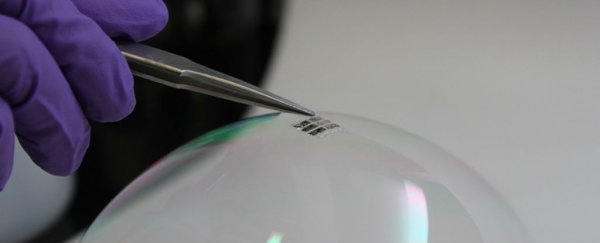Scientists have invented incredibly thin, flexible photovoltaic cells that are so lightweight, they can rest on top of soap bubbles without breaking them. Cells this thin and light could eventually be placed almost anywhere, from smart clothing to helium balloons.
"It could be so light that you don't even know it's there, on your shirt or on your notebook," said one of the researchers, Vladimir Bulović from MIT. "These cells could simply be an add-on to existing structures."
It's that versatility that makes the experiment so exciting - even if it's still only a proof-of-concept at this stage. Key to the creation of the new cell is the way the researchers have combined making the solar cell itself, the substrate that supports it, and its protective coating, all in one process.
One advantage is that by growing the cell and the substrate together, the latter can be protected from dust and other contaminants. A common flexible polymer called parylene was used as both the substrate and the overcoating, while an organic material called DBP (dibutyl phthalate) was used as the primary light-absorbing layer.
Unlike conventional approaches to solar cell manufacturing, the whole process takes place in a vacuum chamber at room temperature, and without the use of any solvents or harsh chemicals. Vapour deposition techniques – where heat, pressure, and chemical reactions create a very thin coating of a particular material – are used to grow the substrate and the solar cell together.
The MIT team says it's this technique, rather than the materials used, that makes the breakthrough so significant.
The resulting ultra-thin and flexible cells are just one-fiftieth of the thickness of a human hair and one-thousandth of the thickness of existing glass-based cells (about 2 micrometres thick), but they can convert sunlight into electricity just as efficiently.
In fact, they may be too thin to be practical: "If you breathe too hard, you might blow it away," said Joel Jean, another of the researchers involved.
According to the inventors of the new process – which has taken years to perfect – this vacuum-based layering could be used to deposit solar cells on top of fabric, paper, or almost any other material. In space or at high altitude, where weight is important, these cells could have an important role to play, even if mass producing them at scale is going to take several more years of work.
The team's findings have been published in Organic Electronics.
